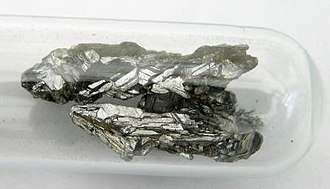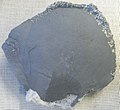Arsenic
Arsenic is chemical element 33 on the periodic table. Its symbol is As. Its atomic number is 33 and its atomic mass is 74.92. It is a toxic metalloid. It is in the pnictogen group on the periodic table.
Properties
Physical properties
Arsenic is found in three allotropes. Gray arsenic is the most common. It is a brittle, somewhat soft metalloid that is a little shiny. It has a density of 5.73g/cm3. It is a semiconductor. Yellow arsenic is unstable and rare. It is the most toxic allotrope. It is a soft and waxy nonmetal, similar to white phosphorus. It turns into gray arsenic in light. Its density is 1.97g/cm3, much lighter than gray arsenic. It is created when arsenic vapor (made by heating arsenic very hot) is cooled very fast by something like liquid nitrogen. Black arsenic is similar to red phosphorus. It is a brittle, black, and shiny nonmetal. It does not conduct electricity. Since gray arsenic is the most common, it is usually referred to as arsenic.
Arsenic is found as one stable (nonradioactive) isotope, 75As. There are about 33 radioactive isotopes found. The longest lasting one is 73As, which has a half life of about 80 days.
Chemical properties
Arsenic is a relatively chemically inert element, similar to copper in reactivity. It burns in air to make garlic-smelling arsenic trioxide. Arsenic, as well as some of its compounds, do not have a liquid state; they sublime. Arsenic reacts with fluorine to make arsenic pentafluoride. It reacts with the rest of the halogens to make the arsenic trihalides. Arsenic does not dissolve in hydrochloric acid. It dissolves in concentrated nitric acid to make arsenic acid and in dilute nitric acid to make arsenious acid. It reacts with concentrated sulfuric acid to make arsenic trioxide. Arsenic burns with a pale lavender flame.
Chemical compounds
Arsenic forms chemical compounds in three oxidation states: -3, +3, and +5. -3 compounds are reducing agents. They are the main form of arsenic in the ground (as arsenides). Arsine is a colorless, highly toxic gas with a garlic odor. The +3 state is the most common. They are weak oxidizing agents. Arsenic trioxide is a white solid. It dissolves in water to make a solution of arsenious acid. The arsenic trichlorides are low melting covalent solids. The +5 state is common, too. They are strong oxidizing agents. Arsenic pentafluoride, a colorless and highly reactive gas, is the only stable arsenic pentahalide. Arsenic pentoxide dissolves in water to make arsenic acid, which can make arsenate salts.
- -3 compounds
-3 compounds are reducing agents. They are found as arsenides and arsine. The metal arsenides have properties between an alloy and a salt.
- Aluminum arsenide
- Arsenide, the ion
- Arsine, colorless highly toxic flammable gas
- Gallium arsenide, used in LEDs
- Zinc arsenide
- +3 compounds
+3 compounds are weak oxidizing agents. Many are colorless, although some are orange.
- Arsenic tribromide, white solid
- Arsenic trichloride, colorless liquid
- Arsenic trifluoride, colorless liquid
- Arsenic triiodide, red-orange solid
- Arsenic trioxide, white solid
- Arsenic trisulfide, yellow solid
- Arsenates
Arsenates are salts of arsenious acid.
- Arsenious acid, weak acid
- Arsenate, the ion
- Paris green, copper acetoarsenite (copper acetate arsenite), green solid
- Potassium arsenite
- Sodium arsenate
- +5 compounds
+5 compounds are strong oxidizing agents.
- Arsenic pentafluoride, colorless gas
- Arsenic pentoxide, white solid
- Arsenates
Arsenates are salts of arsenic acid.
- Arsenate, the ion
- Arsenic acid, white solid or colorless solution
- Lead arsenate
- Potassium arsenate
Occurrence
Arsenic is found sometimes as an element in the ground, but is normally found in minerals. Some arsenic minerals have a metal and sulfur along with arsenic. Arsenopyrite is iron arsenic sulfide. It is the same as pyrite with arsenic added. Other arsenic minerals have a metal and arsenic. Erythrite, a cobalt arsenide mineral, is an example. Other arsenic minerals are simple. Realgar and orpiment (arsenic sulfides), simple arsenic minerals, are ores of arsenic.
Arsenic is found as a less toxic variety in fish and mushrooms. Some people think that humans need very small amounts of arsenic to be healthy. Some bacteria can use arsenic instead of phosphorus for some things; they are called arsenic bacteria.
Preparation
Most arsenic is made from the waste products after other metals are processed. Only China actually mines arsenic.
Arsenic is made from arsenopyrite by heating it. This makes arsenic trioxide which sublimes (along with sulfur dioxide), while the iron oxide stays behind. The arsenic trioxide is condensed, while the sulfur dioxide does not condense. The arsenic trioxide can be reduced with carbon. Another way is to heat the arsenopyrite without air. Then gray arsenic is made. Realgar can be heated to make arsenic trioxide as well.
History
Arsenic was known since antiquity. It was alloyed with bronze to make the bronze harder. Some people used arsenic as make-up, although it was toxic. Arsenic was well known as a poison. Since people used it to kill royalty and it was hard to detect, it was called the "Poison of Kings" and the "King of Poisons". An arsenic compound could have been the first organometallic compound (a metal bonded to an organic compound).
Uses
Arsenic compounds were used as a preservative for wood. Once people saw how toxic arsenic was, they stopped using it to preserve wood. Some feed for animals had arsenic in it to prevent disease. Lead arsenate was used as an insecticide in orchards but damaged the brains of those who put the insecticide on the trees.
Arsenic was used in medicines in the 1700s, 1800s, and 1900s. Arsenic trioxide was used to treat cancer. Very tiny doses of arsenic compounds can act as stimulants. Some arsenic compounds are used as poison gases.
Arsenic as an element is used in alloys. The lead in lead acid batteries has some arsenic in it to make it stronger. Some semiconductors have arsenic in them.
Copper arsenate was used as a coloring for sweets. Paris green, a green pigment having arsenic in it, made many people sick. Some bullets have arsenic in them. Arsenic is sometimes added to brass to prevent the zinc from coming out. Arsenic was used in optical glass but was taken out because it was toxic.
The trioxide was once used as a rat poison.
Safety
Arsenic and its compounds are highly toxic. They are carcinogens.[1] Water near arsenic mines is normally contaminated with arsenic. Wood that was preserved with arsenic compounds can leach arsenic into the soil. Emissions from coke ovens have arsenic in them.
Arsenic Media
Alchemical symbol for arsenic
The arsenic labyrinth, part of Botallack Mine, Cornwall
Satirical cartoon by Honoré Daumier of a chemist giving a public demonstration of arsenic, 1841
Roxarsone is a controversial arsenic compound used as a feed ingredient for chickens.
















